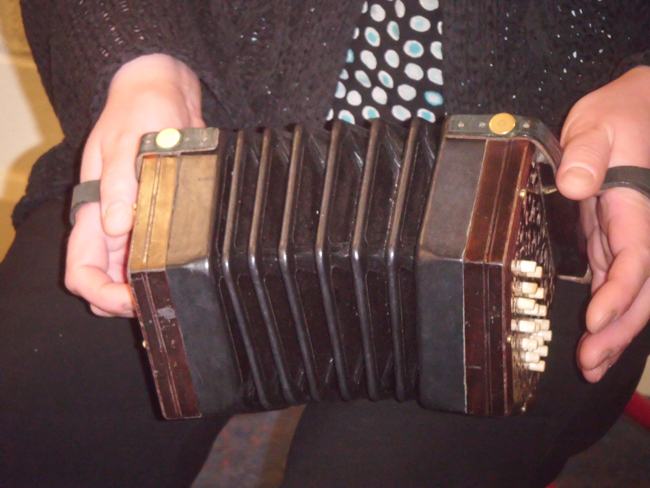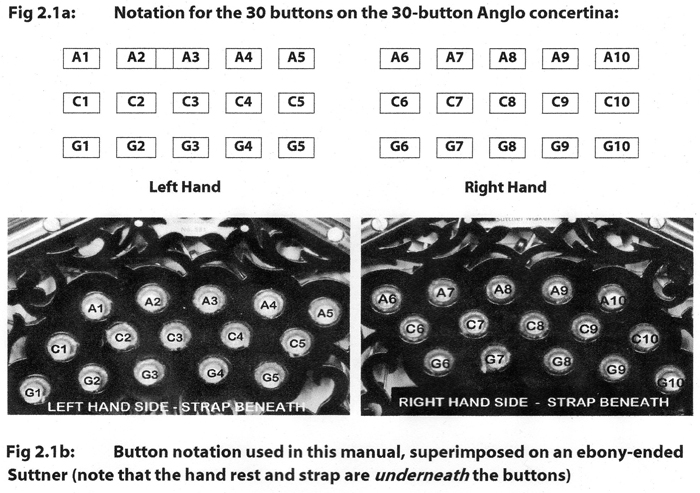The Concertina Diaries arose from Heather Greer's own learning of the 30-button Anglo concertina. Heather plays Irish trad and, along with partner Mary Lovett, for many years they ran Dusty Banjos (a set of weekly learning classes specifically for adults), runs sessions, and loves teaching, most especially adults.
Before much time had passed, Heather discovered that she needed a tutor. Not being in a position at the time to attend a teacher, she looked around at what was available in printed form to help guide her. With just one or two exceptions (mentioned in her book), Heather soon found that what was available was largely unhelpful.
It was this lack of available learning tutors/manuals that inspired Heather to put together this self-help manual. The result of over three years of hard work, the manual is indeed based on Heather's own diaries, maintained over this period as she delved into the intricacies and joys of learning and playing the Anglo concertina.
 The
Anglo concertina isn't a straightforward instrument, because the notes
most commonly used can be played (well, many of them, anyway) using two
or even three different buttons. This means there is a large number of
ways of playing any given passage of a tune. As the saying goes, "there are many ways to skin a cat"!
The
Anglo concertina isn't a straightforward instrument, because the notes
most commonly used can be played (well, many of them, anyway) using two
or even three different buttons. This means there is a large number of
ways of playing any given passage of a tune. As the saying goes, "there are many ways to skin a cat"!And there are "principles" for playing the Anglo smoothly; for example, a key rule is to avoid "chopping" - using the same finger to play two consecutive notes on two different buttons. In this respect, it's a bit like learning a language. When speaking, you can - and of course do - say the same thing in many different ways.
And, like learning a language, there are different approaches to learning. One is to start with the 'grammar' - the musical equivalent would be the scales - and then build a small amount of vocabulary. And go from there. That is the way most concertina teachers work, partly perhaps because (a) it's a convenient method when teaching a class, and (b) it can get you going on a range of tunes that 'fit' the limited number of buttons that have been taught in order to play a given scale.
An alternative way is to learn in a way similar to how you would learn a foreign language if you went and lived in a country where it was spoken. That is, you would simply learn how to say some things that are helpful in getting by on a day-to-day basis, and build your ability to speak and understand more or less with the grammar following along as needed - or when it's helpful to learn some grammar.
THE CONCERTINA DIARIES follows this alternative approach.

If you read the introductory chapters, and if
you apply yourself regularly to "speaking" the tunes as they're
introduced and explained, you will find your fingers gain the knowledge
they need, in order to play a tune - with or without using sheet music
to help.
One of the helpful diagrams from Chapter Two, showing
you the simple method of labelling the buttons. In this
manual, you're shown the exact buttons to use in playing
the 47 tunes included - and you're told why those buttons!
manual, you're shown the exact buttons to use in playing
the 47 tunes included - and you're told why those buttons!
To guide you, the "Diaries" shows you a simple concertina 'notation' (see above), and provides you with the music not alone in standard musical notation and ABC, but also in concertina notation - so your fingers are guided to the buttons that play the tune you're working on, while at the same time they 'obey' simple principles, such as the "avoid chopping" principle mentioned above. The book contains lots of help, along with many snippets of information both about the concertina and about playing Irish music in sessions.
If you give it the time, you'll find that The Concertina Diaries will help you to learn, surprisingly quickly. You'll enjoy the journey. And you will succeed!
As we explained earlier, The Concertina Diaries is primarily intended for beginners on the concertina (probably 30-button, though not necessarily), as well as for those who already have some ability but want to explore the possibilities of this beautiful and fascinating instrument in greater depth.
The book comes with a CD containing recordings of all 47 tunes, played as they're written in the manual, and very slowly, to aid learning. Meanwhile, we've recorded the early tunes in the manual, played slowly, to assist your learning; they're up on this website - just click HERE to listen to the first fifteen tunes.